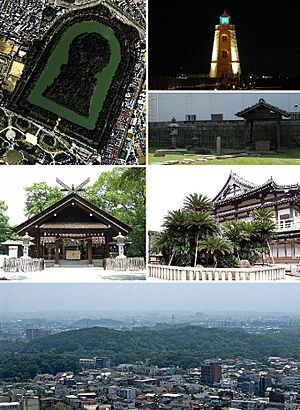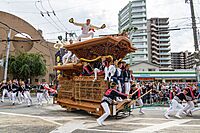Sakai facts for kids
Quick facts for kids
Sakai
堺市
|
|||||||||||||
|---|---|---|---|---|---|---|---|---|---|---|---|---|---|
| Sakai City | |||||||||||||

From top left: Daisen Kofun, Old Sakai Lighthouse, Ruins of Rikyu's house, Ōtori taisha, Myōkoku-ji, Skyline with Daisen kofun in the center
|
|||||||||||||
|
|||||||||||||
 |
|||||||||||||
| Country | Japan | ||||||||||||
| Region | Kansai | ||||||||||||
| Prefecture | Osaka | ||||||||||||
| Area | |||||||||||||
| • Total | 149.82 km2 (57.85 sq mi) | ||||||||||||
| Population
(January 1, 2022)
|
|||||||||||||
| • Total | 819,965 | ||||||||||||
| • Density | 5,473.00/km2 (14,175.0/sq mi) | ||||||||||||
| Time zone | UTC+09:00 (JST) | ||||||||||||
| City hall address | 3-1 Minami-Kawaramachi, Sakai-ku, Sakai-shi, Osaka-fu 590-0078 | ||||||||||||
| Climate | Cfa | ||||||||||||
|
|||||||||||||
Sakai (Japanese: 堺市, Hepburn: Sakai-shi) is a big city in Osaka Prefecture, Japan. It has been a very important seaport for a long time, since the Middle Ages. Sakai is famous for its kofun. These are special keyhole-shaped burial mounds from the 5th century. One of them, Daisen Kofun, is the biggest grave in the world by its area!
Sakai was once known for making swords. Today, it is famous for its high-quality cutlery, which are special knives. As of January 1, 2022, about 819,965 people lived in Sakai. This makes it the fourteenth largest city in Japan, not counting Tokyo.
Contents
Geography of Sakai
Sakai is located in the southern part of Osaka Prefecture. It sits right on the edge of Osaka Bay, just south of the city of Osaka.
Cities near Sakai
Sakai is surrounded by several other cities in Osaka Prefecture:
- Osaka
- Matsubara
- Habikino
- Ōsakasayama
- Kawachinagano
- Izumi
- Takaishi
Sakai's Climate
Sakai has a Humid subtropical climate. This means it has warm summers and cool winters. There is usually little to no snow. The average temperature in Sakai is about 16.5 degrees Celsius (61.7 degrees Fahrenheit) each year. June is usually the wettest month. The hottest month is August, with temperatures around 28.6 degrees Celsius (83.5 degrees Fahrenheit). January is the coldest, with temperatures around 5.6 degrees Celsius (42.1 degrees Fahrenheit).
Sakai's Population
The number of people living in Sakai grew very quickly in the 1960s and 1970s. Since then, the population has stayed about the same.
| Historical population | ||
|---|---|---|
| Year | Pop. | ±% |
| 1960 | 383,559 | — |
| 1970 | 616,558 | +60.7% |
| 1980 | 839,421 | +36.1% |
| 1990 | 844,899 | +0.7% |
| 2000 | 829,636 | −1.8% |
| 2010 | 842,132 | +1.5% |
| 2020 | 826,161 | −1.9% |
History of Sakai
Early History and Kofun
People have lived in the Sakai area for a very long time, since about 8,000 BC. Sakai is famous for its keyhole-shaped burial mounds, called kofun. These date back to the 5th century. The biggest kofun is Daisen Kofun. Many people believe it is the grave of Emperor Nintoku. It is the largest grave in the world by area. Between 300 and 500 AD, over one hundred burial mounds were built in the Mozu Tumulus Cluster. The name "Sakai" first appeared in a poem around 1045.
Sakai in the Middle Ages
During the Muromachi and Sengoku periods (from about 1450 to 1600), Sakai became one of Japan's richest cities. It was a busy port for trade with other countries. Sakai was known for making textiles and iron goods. People used to say that the richest cities were "Sakai by the sea, Imai inland."
The famous Zen Buddhist priest Ikkyū chose to live in Sakai because it was a very free and open city. Sen no Rikyū, a great master of the Japanese tea ceremony, was also from Sakai. Because of its wealth and connection to Zen Buddhism, Sakai was a main center for the tea ceremony in Japan.
Christian missionaries, like Francis Xavier, visited Sakai in the 1500s. They wrote about how rich the city was. One visitor, Gaspar Vilela, said Sakai was the safest place in the area in 1561. He also noted that the city was "governed by consuls like Venice in Italy."
After Europeans arrived, Sakai started making matchlock firearms. A powerful leader named Oda Nobunaga bought many guns from Sakai. Nobunaga wanted to unite Japan. He tried to take away Sakai's special freedom. The people of Sakai fought against his army. Most citizens left, and Sakai was burned and taken over by Nobunaga.
After Nobunaga died in 1582, Toyotomi Hideyoshi took power. He ended Sakai's self-governing system. This made many merchants move to his city, Osaka.
In 1615, Sakai was destroyed during a battle between the Toyotomi clan and Tokugawa Ieyasu.
Sakai became an important trade center again during the Edo period. However, Japan was closed off from the rest of the world then. So, Sakai only traded within Japan. It was also known for making sake (rice wine) and cutlery. Later, when Japan opened up again, Sakai was involved in the Sakai Incident. This was a fight between French sailors and Japanese police.
Modern Sakai
After the Meiji restoration, Sakai became an industrial city. It made textiles and bricks. In 1945, the city was bombed many times during World War II. This caused a lot of damage and loss of life.
In 2006, Sakai became a "designated city." This means it has more control over its own government.
Sakai's Economy
Sakai used to rely on heavy industries and its port. After World War II, the city grew a lot. It also became a "commuter town" for Osaka. This means many people live in Sakai but work in Osaka. Shimano, a big company that makes bike parts and fishing gear, is based in Sakai. Kura Sushi, a popular conveyor belt sushi restaurant chain, also has its main office in Sakai.
Education in Sakai
Universities in Sakai
- Osaka Prefecture University
- Hagoromo International University
- Kansai University Sakai Campus
- Poole Gakuin University
- Taisei Gakuin University
- Tezukayama Gakuin University
- Osaka Butsuryo University
- Osaka Junior College of Social Health and Welfare
- Sakai Women's Junior College
Schools in Sakai
Sakai has many schools for children. The city government runs 98 public elementary schools and 43 public middle schools. There are also private schools, including some that combine middle and high school. The Osaka Prefecture runs 23 public high schools in Sakai. There are also special education schools for students with disabilities.
Transportation in Sakai
Airports
Sakai does not have its own airport. The closest big airport is Kansai International Airport.
Trains and Subways
Sakai has many train lines that connect it to other parts of Japan.
- JR West – Hanwa Line
- Asaka - Sakaishi - Mikunigaoka - Mozu - Uenoshiba - Tsukuno - Ōtori
- Nankai Electric Railway - Nankai Main Line
- Shichidō - Sakai - Minato - Ishizugawa - Suwanomori - Hamaderakōen
- Nankai Electric Railway - Kōya Line
- Asakayama - Sakaihigashi - Mikunigaoka - Mozuhachiman - Nakamozu - Shirasagi - Hatsushiba - Hagiharatenjin - Kitanoda
- Semboku Rapid Railway Co., Ltd. - Semboku Rapid Railway
- Nakamozu - Fukai - Izumigaoka - Toga-Mikita] - Kōmyōike
Sakai also has a subway line:
- Osaka Metro - Midōsuji Line
- Kitahanada - Shinkanaoka - Nakamozu
Tramway
The Hankai Tramway runs through Sakai:
- Hankai Line: (from Sumiyoshi-ku, Osaka) - Yamatogawa - Takasu-jinsha - Ayanocho - Shimmeicho - Myokokuji-mae - Hanataguchi - Oshoji - Shukuin - Terajicho - Goryomae - Higashi-Minato - Ishizu-Kita - Ishizu - Funao - Hamaderakōen
Buses and Highways
Several bus companies operate in Sakai, including Nankai Bus and Kintetsu Bus. Sakai is also connected by major highways and expressways, making it easy to travel by car.
Sakai's International Connections
Sakai has special relationships with cities around the world.
Sister Cities
 Berkeley, California, United States (since 1967)
Berkeley, California, United States (since 1967) Lianyungang, Jiangsu, China (since 1983)
Lianyungang, Jiangsu, China (since 1983) Wellington, New Zealand (since 1994)
Wellington, New Zealand (since 1994)
Friendship Cities
 Tanegashima, Kagoshima, Japan (since 1986)
Tanegashima, Kagoshima, Japan (since 1986) Higashiyoshino, Nara, Japan (since 1986)
Higashiyoshino, Nara, Japan (since 1986) Da Nang, Vietnam (since 2019)
Da Nang, Vietnam (since 2019)
Famous People from Sakai
Many well-known people are from Sakai, including:
- Sen no Rikyū, who started the modern Tea ceremony
- Emperor Nintoku, a very old Japanese emperor
- Ikkyū, a famous Zen Buddhist monk and poet
- Kenzō Tange, an award-winning architect
- Oreskaband, an all-female ska band
- Kana-Boon, a Japanese rock band
- Akiko Yosano, a famous poet and novelist
- Hideo Nomo, a well-known baseball player
- Musashi (kickboxer), a famous kickboxer
- Fuka Koshiba, a Japanese actress
Places to Visit in Sakai
- Mozu Kofun Cluster: See the ancient burial mounds.
- Sakai City Museum: Learn about the city's history.
- Sakai Matsuri: A fun festival in Sakai.
- Tsukuno Danjiri Matsuri: Another exciting festival with traditional floats.
Images for kids
-
Gunsmith storefront in Sakai, Osaka
See also
 In Spanish: Sakai (Osaka) para niños
In Spanish: Sakai (Osaka) para niños

















